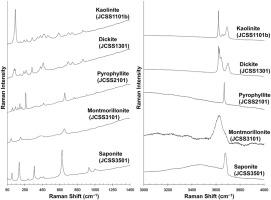Vibrational Spectroscopy ( IF 2.7 ) Pub Date : 2021-03-20 , DOI: 10.1016/j.vibspec.2021.103247 Kei Ikehata , Yoji Arakawa , Jun-ichiro Ishibashi

|
We used micro-Raman spectroscopy to analyze volcanic ejecta from the 7 March 2012 phreatic eruption at Old Crater (Million Dollar Hole) on Ioto Island, Izu-Bonin arc, Japan, to assess the ability of this technique to identify clay and other alteration minerals in volcanic ejecta. We also analyzed five reference clay minerals (kaolinite, dickite, pyrophyllite, montmorillonite, and saponite) using the same technique. Dickite, montmorillonite, gypsum, pyrite, marcasite, quartz (α-quartz), and anatase were identified by comparison with spectra of the reference materials and published databases. These minerals occur in close spatial association with each other. Marcasite, quartz, and anatase in aliquots of the sample were not observed by a previous powder X-ray diffraction (XRD) study. The presence of dickite, montmorillonite, gypsum, quartz, marcasite, and anatase indicates that these alteration minerals were likely derived from the acidic alteration zone (150–190 °C) below the crater on Ioto Island. Our results demonstrate that Raman microspectroscopy, compared with conventional XRD, is a more sensitive technique for identifying and characterizing alteration minerals present in the volcanic ejecta. However, owing to the strong fluorescence from clay minerals during Raman analysis, the presence of other minerals in the sample may be overlooked. Therefore, the use of the two techniques in combination can be a powerful tool for obtaining a full understanding of mineral phases in volcanic ejecta from phreatic eruptions, thereby providing more accurate information on the hydrothermal conditions below volcanic craters.
中文翻译:

2012年3月7日日本伊豆-波宁弧伊豆岛(硫磺岛)潜水爆发以来火山喷出物中参考粘土矿物和蚀变矿物的拉曼光谱研究
我们使用微拉曼光谱法分析了2012年3月7日日本伊豆博宁弧州伊奥托岛老火山口(百万美元洞)的火山喷发,以评估该技术识别粘土和其他蚀变矿物的能力在火山喷出物。我们还使用相同的技术分析了五种参考粘土矿物(高岭石,地开石,叶蜡石,蒙脱石和皂石)。通过与参考物质的光谱和已发布的数据库进行比较,鉴定出了迪克石,蒙脱石,石膏,黄铁矿,镁铁矿,石英(α-石英)和锐钛矿。这些矿物质彼此之间存在紧密的空间联系。以前的粉末X射线衍射(XRD)研究未观察到等份试样中的镁铁矿,石英和锐钛矿。地闪石,蒙脱石,石膏,石英,镁铁矿的存在,锐钛矿表明这些蚀变矿物很可能来自伊奥托岛火山口下方的酸性蚀变带(150–190°C)。我们的研究结果表明,与常规XRD相比,拉曼光谱法是一种更灵敏的技术,用于识别和表征火山喷出物中存在的蚀变矿物。但是,由于在拉曼分析过程中粘土矿物发出的强烈荧光,因此样品中其他矿物的存在可能会被忽略。因此,结合使用这两种技术可以成为一种强大的工具,可以全面了解潜水喷发引起的火山喷出物中的矿物相,从而提供有关火山口下方水热条件的更准确信息。











































 京公网安备 11010802027423号
京公网安备 11010802027423号